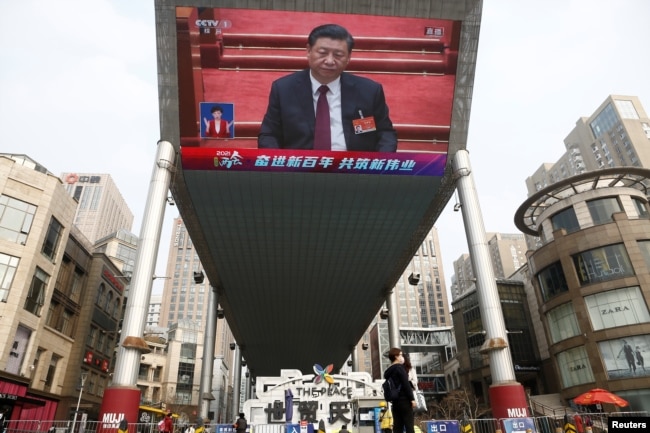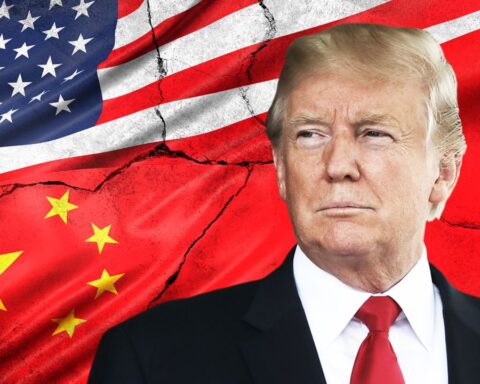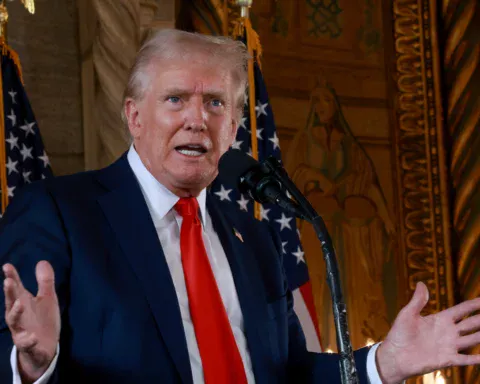The future direction came as the Chinese Communist Party’s legislature, the National People’s Congress, convened in Beijing on March 5 for a more-than-week-long gathering to unveil a new economic blueprint — known as the country’s 14th five-year plan — and chart a broad course for China to claim its place as a modern nation and true global power.
The annual summit of Chinese lawmakers laid out broad guidelines that would shape the country’s growth model over the next 15 years.
Preoccupied with growing China’s tech industry amid a deepening rivalry with the United States, it also provided a platform for Xi to tout the merits of his autocratic style and tightening grip on power at home.
While the stagecraft of the conclave focused on China’s domestic goals, they remain deeply intertwined with Beijing’s global ambitions, particularly the Belt and Road Initiative (BRI) — a blanket term for the multibillion-dollar centerpiece of Xi’s foreign policy that builds influence through infrastructure, investment, and closer political ties.
“The message is a continuation and doubling-down of what we’ve been seeing for years, which is that China is growing stronger and it feels confident to elbow its way in even more around the world,” Raffaello Pantucci, a senior associate fellow at London’s Royal United Services Institute, told RFE/RL.
Chinese Foreign Minister Wang Yi echoed this during an expansive March 8 press conference on the sidelines of the congress in Beijing, where he said there would be no pause for BRI and that it had and would continue to evolve amid the constraints and opportunities caused by the pandemic.
“[BRI] isn’t so much a specific project as it is a broad vision,” Pantucci said, “and visions can be reshaped as needed, which is what we’re seeing now.”
An Evolving Vision
Despite the display of strength and unity coming out of Beijing over the country’s success in curbing the spread of COVID-19 and keeping its economy growing amid the pressures of the pandemic, Beijing finds itself facing new global pressure.
The BRI has suffered setbacks recently due to concerns in host countries over mounting debts, with many governments — from Africa to Central Asia — asking China for debt forgiveness and restructuring. Beijing is also looking to rebuild its credibility, which was hurt over its early handling of COVID-19 in the central city of Wuhan, and navigate growing pressure from Western countries that have begun to push back against Chinese tech and political policies.
In the face of this, Beijing has looked for new opportunities to demonstrate global leadership, providing vaccines and medical equipment to countries across the globe and raising climate-change concerns.
This has also applied to the BRI.
During his press conference, Wang focused on the initiative’s traditional infrastructure emphasis, but also pointed towards new horizons for the policy, such as medical diplomacy as well as a shifting focus on tech and foreign aid. China is the world’s largest emerging donor and a new white paper released in January by the Chinese government outlined its plans to play an ambitious leading role in the international aid system.
Many experts also say Beijing will look to build off its growing “vaccine diplomacy” campaign and use China’s recent success in fighting poverty to find new ways to build ties and deepen cooperation around the world.
“Fighting poverty and medical coordination linked to the pandemic and its aftermath will be a major focus of Chinese diplomacy moving forward,” Zhang Xin, a research fellow at Shanghai’s East China Normal University, told RFE/RL. “[BRI] is an umbrella initiative that can include everything and this will be one of the new fronts under that umbrella.”
Realities On The Ground
Despite the growing opportunities, China’s flagship project is also facing plenty of challenges from the COVID-19 pandemic on the ground.
In addition to debt concerns, closed or partially open borders with China’s neighbors in South and Central Asia due to China’s strict COVID restrictions remain a point of tension, and have led to massive lines, trade bottlenecks, and ballooning transportation costs.
China’s overseas energy lending has likewise dropped to its lowest level since 2008, after the pandemic severely hampered deal-making in developing states, according to Boston University’s Global Energy Finance Database, which saw financing for foreign energy projects fall by 43 percent to $4.6 billion in 2020.

And while the pandemic provided an all-time high for freight-train traffic to Europe from China, it has slowed trade from Central Asia to China. Only limited traffic is allowed to pass through China’s border post with Kyrgyzstan, something the new government in Bishkek is trying to change as it deals with the economic blows of the pandemic.
Kyrgyz Prime Minister Ulukbek Maripov met with Du Dewen, China’s ambassador to Bishkek, on March 3 to discuss speeding up border crossings and increasing trade, but progress remains uncertain as long as China stays wary of the spread of COVID-19 in Central Asia.
Similarly, traders in Tajikistan are still grappling with border closures as they remain cut off from their main export destination. Many of the merchants complain they are being squeezed out by Chinese competitors.
Preliminary Chinese trade data for 2020 shows that imports to China from Kyrgyzstan and Tajikistan fell by more than 45 percent compared to 2019.
Tensions also continue to flare in Pakistan, where the $62 billion China-Pakistan Economic Corridor (CPEC), China’s flagship BRI project, is progressing slowly amid multiple setbacks and delays. While problems with the initiative are not new, Beijing has aired its frustrations and supported the Pakistani military taking greater control over CPEC, which it views as a more reliable partner than the country’s political class.
Global Headwinds
Trade and relations with neighboring Russia, however, appear to still be a bright spot for Beijing. Russian customs figures show that China continues to make up a growing share of its trade as Moscow increasingly finds itself sanctioned and cut off from the West.
Political ties between Beijing and Moscow are also deepening. Wang spoke at length at his press conference about how the two governments were working closer together in a variety of fields, from plans to build a lunar space station to joint efforts in vaccine production.
Wang also said that the two countries were working to combat “color revolutions” and to fight against a “political virus,” hinting at their shared animosity towards the United States.
“The overall tone is quite clear, the partnership between China and Russia is being heavily valued,” Zhang said. “The Chinese state is emphasizing this relationship and how they can act together [with Russia] to face shared challenges around the world.”
Chief among those challenges for Beijing is continuing to grow its economy at home and navigate its rivalry with the United States.
U.S. Secretary of State Antony Blinken and national-security adviser Jake Sullivan will meet with their Chinese counterparts in Alaska on March 18 for the first meeting between Beijing and the administration of President Joe Biden.
China is also looking to take successful policies at home and build upon them abroad under the banner of the BRI. China was the only major world economy to expand last year and many of its neighbors across Eurasia are hoping Chinese economic growth can help them with a post-pandemic recovery.
But China’s own recovery remains fragile in some areas, including in consumer spending, and regulators are growing more worried about real-estate prices rising to unsustainable levels. The Chinese stock market began to recover on March 11 after a large rout that saw officials censor the word “stock market” from social media searches in the country, showcasing the sensitivity to anything that can derail Beijing’s ambitions at home or abroad.
“There are many challenges ahead for the Chinese leadership to navigate and maintaining economic growth is the biggest one,” Ho-Fung Hung, a professor of political economy at Johns Hopkins University, told RFE/RL. “Xi cares about political power and boosting economic growth is the best way to hold on to political power.”
Reid Standish






